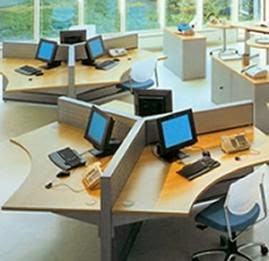Perhaps that's exactly where the trend has come from... and where it should stay.
20 years ago I moved into an open office space. (See, it's not so new after all.) My job at Nav Canada was starting up after a transition from Transport Canada. We moved into a new building with workstations clustered into groups of four. Our desks were simple L-shapes and we sat with our backs completely open.
If you were lucky at least you had full height cube walls in-front, shared with the other people in your "pod".
If you weren't so lucky your wall was only about a foot high, letting you see and hear everything your co-workers were up to.
The cube-farm we had come from wasn't perfect either. At least it gave me some privacy, some quiet to let me to analyze radar data and write my reports.
The new space offered little of this. Our engineering work wasn't driven by the "collaborative thinking" created by such work spaces. Company management hadn't even talked to us about what we needed.
Even today I don't think management considers what their employees really need. They might not admit it, but TV images influence them. And of course there's the economics of the set-up. Maybe money is driving the continuing trend of open office designs.
Consider the cost of renting a traditional office space at about $2.50 per square foot versus 69¢. Then throw a bunch of simple tables in there... and presto, instance office! Just add workers! And sweat. And frustration.
Here's a sampling of some complaints about such workspaces that I read in an article on Businessweek.com:
- The reality is that open office space does not result in high productivity. It results in lower productivity because of all the distractions. It's difficult to concentrate when people around you are on the phone... Or when they're "collaborating" about their commute into the office.
- Not every business or office is collaborative! We don't all need access to our co-workers every moment of every day.
- Open office plans allow non-performers to interfere with the productivity of performers.
- What's worse is loud executives who "manage by walking around". Most have non-relevant conversations with their staff.
- Putting 50+ introverted creatives all in a room staring across from each other can create quite an awkward and taxing day... Day in... Day out...
- Why don't organizations understand that a diverse range of employees makes the organization better? That means allowing for a diverse range of work environments. There are people who naturally do well in open spaces and others fail miserably.
- It's initially cheaper, but the lost in productivity means you might be losing more money in the long run.
- In the late 80s, I worked for newspapers, and newsrooms tended to be noisy and open, lots of give and take. The AP machine was clacking away and the room was smokey and everyone was on the phone interviewing at the same time. You wrote the story with people all around you... Copy editor yelling for it... Production asking you to take a look... Press men in the back waiting for you to finish up. It was cool.
- If you are working as a team or a lot of your job involves regular interaction with your team then I think this is big. I really like it because of the social aspect. Work is a lot more enjoyable when you have people to talk to (provided you like your co-workers).
- As an extroverted person with good co-workers, I love it.
- I prefer having an open office environment that allows me to collaborate with other departments. I want options that keep me from the seclusion of a cube environment. I feed off the energy of other people and the open workspace environment starts my day off productive and energized.
One-size-fits-all is not the solution.
I'm a writer who works from home now. My main office where I do all my writing has walls of windows looking onto my garden. My other "office" where I do much of my thinking is my bicycle. It has no walls - only open roads and open skies. And sometimes the coffee shop environment works well too, but usually just for reading.
As you can see, even as a company of one employee I too have many office environments. Management listens to me. And that should be the take-away lesson.
By Kevin Rokosh

No comments:
Post a Comment